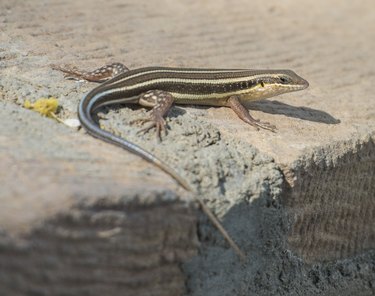
A blue-tailed skink is a black and yellow-striped lizard. It is sometimes called a five-lined skink due to the yellowish stripes on its sides and back that lead into a bright blue tail. They are common in the wild in some parts of the country and also make good pets because they are easy to care for and eat food that is easy to acquire.
This blue-tailed lizard has a striking appearance. Its body size is generally more than five inches but less than nine, with short legs and a long tail that is an electric blue color. These lizards are common in the southeastern United States. The Savannah River Ecology Laboratory at the University of Georgia says they range from Georgia to South Carolina and are common in wooded areas with an abundance of fallen trees and stumps to hide in. Recreating their habitat with plenty of places to hide will make your blue-tailed skink happy in its home with you. Skinks also like moist habitats similar to what you would find along a wooded river.
Video of the Day
Video of the Day
Interestingly, a baby skink of the blue-tailed skink, five-lined skink, southeastern five-lined skink, and broadhead skink is often called a "scorpion." People call them that because they are believed to have a venomous sting. The Savannah River Ecology Laboratory says this is completely false. But the origin of this belief may have come from these skinks being bad-tasting to many predators.
Skink or salamander?
Some people might call a blue-tailed skink a blue-tailed lizard or a blue-tailed salamander. While lizards and salamanders look similar, they are not the same. Lizards do not have the same life cycle that skinks do. Reptile Magazine explains that lizards and skinks are reptiles and salamanders are amphibians. Amphibians have a life cycle in which they are born in water and live in water for their early life. Then, they transition to living life in both water and on land. Reptiles are born on land and live their lives on land.
Habitat for blue-tailed skinks
Pet Ponder says a blue-tailed skink makes a good pet because they are easy to care for. Because they are reptiles, they require a warm spot in which to bask to increase their body temperature. These animals also like abundant places to hide such as caves or rocks they can crawl under. When setting up a habitat such as an aquarium, make sure the skink can not escape from it. Add moss or other plant material, a water source, and rocks and branches for the skinks to climb on.
Pet Depot says skinks like to burrow. You can encourage this behavior by providing deep mulch or a sand-type layer in the habitat. They need 12 to 14 hours of light daily from a full-spectrum fluorescent bulb. They like their temperatures to be 90 degrees Fahrenheit in the basking area to 75 degrees Fahrenheit in a different area of the habitat that can allow them to cool off. They also like high humidity, which can be achieved by lightly misting the enclosure once a day. Female skinks can be kept together, but more than one male in a habitat will result in aggression.
Feeding a blue-tailed skink
In the wild, skinks prey on a wide variety of insects, spiders, and other small bugs. You can feed them live crickets, mealworms, and waxworms. Sprinkle food with calcium daily and use a mineral supplement once or twice a week, according to Pet Depot. Pet Ponder says to feed a baby skink ants, worms, centipedes, and flies. Larger or adult skinks can be fed spiders, grasshoppers, and beetles. When feeding, only give them enough that they can eat within a few minutes.